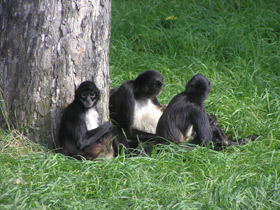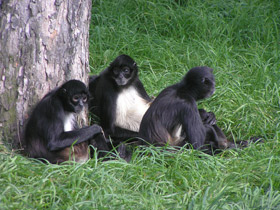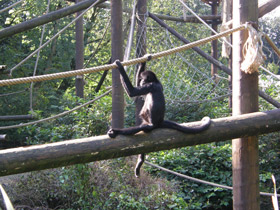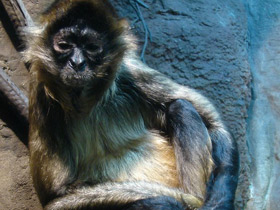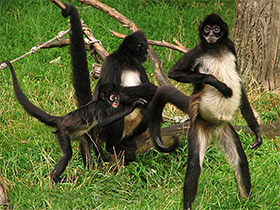Geoffroy's spider monkey (Ateles geoffroyi), the black-handed spider monkey or the Central American spider monkey
Geoffroy's spider monkey видео
Источник: канал Youtube Auto SafariGeoffroy's spider monkey (Ateles geoffroyi), also known as the black-handed spider monkey or the Central American spider monkey, is a species of spider monkey, a type of New World monkey, from Central America, parts of Mexico and possibly a small portion of Colombia. There are at least five subspecies. Some primatologists classify the black-headed spider monkey (A. fusciceps), found in Panama, Colombia, and Ecuador as the same species as Geoffroy's spider monkey.
Description and habitat area
Geoffroy's spider monkey (Ateles geoffroyi), also known as Geoffroy's spider monkey, is also known as the black-handed spider monkey. The species belongs to the family Atelidae (spider and howler monkeys). It is one of the largest of the New World monkeys.
Ateles geoffroyi is distributed from Mexico to northern Colombia, along the Amazonian coast in tropical and evergreen mangrove forests and in the mountain forests of the Andes. This ape is about 60 cm long and has a much longer tail, reaching 80 cm, and a relatively small body weight of 6-9 kg.
Ateles geoffroyi spend most of their time in trees and are very well adapted to arboreal life. They can easily jump from branch to branch at a distance of up to 10 m, and can jump both vertically and horizontally. When Ateles geoffroyi descend to the ground (which happens very rarely), they move on their hind limbs or on all four, bending their tails in a curve. It is not for nothing that these monkeys are called five-armed: their fifth arm, the grasping tail, plays a very important role in movement. The monkey can even pick up small objects with its tail. The tip of its hairless tail is very sensitive and even has special papillary markings, which are individual to each monkey (as humans have on their fingers).
Social behaviour and reproduction
Ateles geoffroyi live in groups of 10 to 40 individuals. When mature, males remain in the group and females leave it. They reproduce very slowly: they do not reach sexual maturity until they are five years old, and females give birth to a young every 4 to 5 years.
Nutrition and special characteristics
Ateles geoffroyi feeds mainly on ripe fruit and travels up to 3 km a day in search of food. This extraordinary primate is endangered due to the destruction of its rainforest habitat. Ateles geoffroyi is included in the IUCN Red List.
Taxonomy
Geoffroy's spider monkey belongs to the New World monkey family Atelidae, which contains the spider monkeys, woolly monkeys, muriquis and howler monkeys. It is a member of the subfamily Atelinae, which includes the spider monkeys, woolly monkeys and muriquis, and of the genus Ateles, which contains all the spider monkeys. The genus name Ateles means "imperfect", a reference to the vestigial thumb. The species name geoffroyi is in honor of French naturalist Étienne Geoffroy Saint-Hilaire.
Agreement over the number of spider monkey species is not universal. Kellogg and Goldman (1944) based their classification on fur color, and Groves (1989) based his on fur color and geographic distribution. Kellogg and Goldman differentiated Geoffroy's spider monkey from other species by its dark black head, hands and wrists. Recent studies use mitochondrial DNA to help differentiate species. Such studies by Collins and Daubach (2000, 2001, 2006) indicate the Geoffroy's spider monkey is more closely related to the white-fronted spider monkey, Ateles belzebuth, and the brown spider monkey, Ateles hybridus, than it is to the red-faced spider monkey, Ateles paniscus. According to these studies, Ateles paniscus branched off from the other spider monkeys approximately 3.27 million years ago and the spider monkeys branched off from the woolly monkeys and muiriquis 3.59 million years ago. Older studies by Porter, et al. indicate the howler monkeys are believed to have branched off from the other Atelides over 10 million years ago.
Subespecie
- Ateles geoffroyi azuerensis;
- Ateles geoffroyi frontatus;
- Ateles geoffroyi geoffroyi;
- Ateles geoffroyi grisescens;
- Ateles geoffroyi ornatus;
- Ateles geoffroyi vellerosus;
- Ateles geoffroyi yucatanensis.
Predators
Large cats – jaguars and pumas – appear to be the only significant adult spider monkey predators, other than humans. Eagles and large snakes are also potential predators. However, predation of Geoffroy's spider monkey has not been observed by researchers.
Conservation status
Geoffroy's spider monkey is listed as endangered by the IUCN, mostly due to habitat loss and capture for the pet trade. It requires large tracts of primary forest to survive, so it is vulnerable to deforestation and is sometimes hunted by humans and captured for the pet trade. Because of its low reproductive turnover, it cannot quickly replenish its numbers when affected by these events. As a result, Geoffroy's spider monkey has disappeared from some areas where it was once common. Three subspecies are critically endangered.
Geoffroy's spider monkey was extirpated on Barro Colorado Island in Panama. Hunting had eliminated the native population there by 1912. However, between 1959 and 1966, an effort was made to reintroduce the species to Barro Colorado. At least 18 monkeys were reintroduced, but only five, one male and four females, survived the reintroduction. This small group has thrived, and the island population had grown to 28 monkeys by 2003.
In culture
- The Mexican painter Frida Kahlo's Self-Portrait with Monkey 1938 portrays this species; the artist kept several of them as pets.
- In the Cartoon Network series Camp Lazlo, the title character is an orange Geoffrey's Spider Monkey with a really long tail.

















